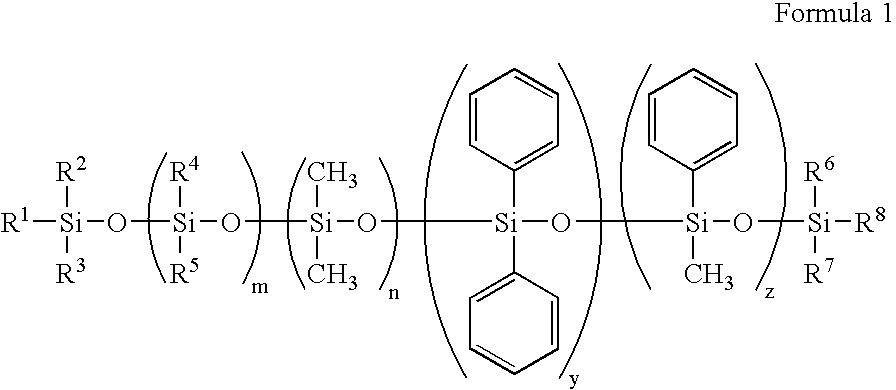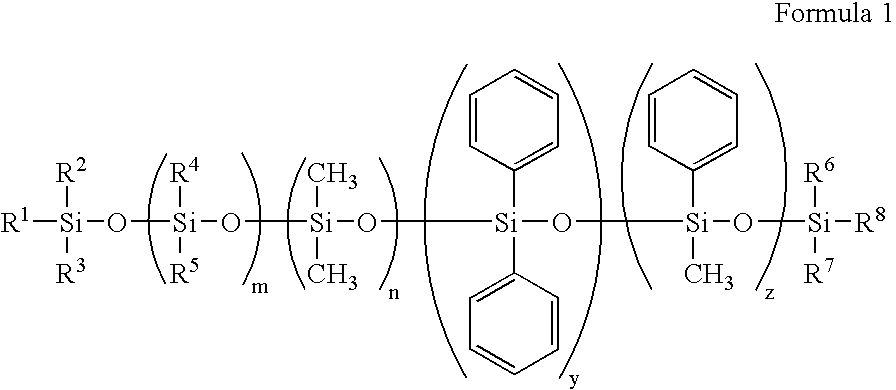Silicone containing polymeric materials
a polymer and polymer technology, applied in the field of polymer materials, can solve the problems of damage to the corneal endothelium, adversely affecting the optical quality of implants, and inability to fold iols without drawbacks
- Summary
- Abstract
- Description
- Claims
- Application Information
AI Technical Summary
Benefits of technology
Problems solved by technology
Method used
Image
Examples
example 1
Preparation of Polymers
[0070]A. The following is an example of the synthesis of a hexavinyl terminated silicone fluid without pendent vinyl groups. In a method for making this polymer (polymer B38), 103.48 grams of octaphenylcyclotetrasiloxane was placed in a preheated 1000 mL reaction kettle at 105° C. (±10° C.). The mechanical stirrer was turned on and the system was purged with nitrogen for at least 30 minutes. Next, 691.78 grams of octamethylcyclotetrasiloxane and 5.15 grams of hexavinyl dislioxane were added together to the reaction kettle. Then, 3.17 grams of tetramethylammonium siloxanolate was added to the reaction kettle. Stirring continued for at least 68 hours at 105° C. (±10° C.). The temperature of the kettle was then raised to 150° C. (±20° C.) for at least 5 hours. After cooling, the silicone fluid was filtered through a 0.2 micron filter.
[0071]B. The following is an example of the synthesis of a hexavinyl terminated silicone fluid with pendent vinyl groups. In a meth...
example 2
Preparation of Disc 1
[0076]In a vessel, 0.045 grams of platinum-cyclovinylmethylsiloxane complex, was added to 15 grams of the B38 0.25% UVAM silicone fluid. The mixture was well mixed by high speed centrifugation at least twice for 30 seconds. The resulting formed “Part A” of the silicone fluid. The final catalyst concentration of three otherwise identical silicone fluids was, by weight, about 0.1%, to about 0.5%. In a separate vessel, “Part B” of the silicone fluid was prepared by mixing 0.4038 grams of 25-30% methylhydrosiloxane-dimethylsiloxane copolymer, trimethylsiloxane termineated, (HMS-301 from Gelest) with 5 grams of the B38, 0.25% UVAM silicone fluid prepared above. Five grams of Part A and 5 grams of Part B were mixed in a vessel with a theoretical H / V ratio=1.0.
[0077]The resulting silicone mixture was poured into a Teflon® mold and the mold was placed in an oven at 140° C. for 10 minutes. Moduli of these discs (before and after extraction) were measured using a Q800 DMA...
example 3
Preparaton of Disc 2
[0078]In another example, In a vessel, 0.045 grams of platinum-cyclovinylmethylsiloxane complex, was added to 15 grams of the B38 0.25% UVAM silicone fluid. The mixture was well mixed by high speed centrifugation at least twice for 30 seconds. In a separate vessel, “Part B” of the silicone fluid was prepared by mixing 0.0908 grams of phenyltris(dimethylsiloxy)silane and 5 grams of B38 silicone fluid. Five grams of Part A and 5 grams of Part B were mixed in a vessel with a theoretical H / V ratio=0.5.
[0079]The resulting silicone mixture was poured into a Teflon® mold and the mold was placed in an oven at 140° C. for 10 minutes. Moduli of these discs (before and after extraction) were measured using a Q800 DMA (TA Instruments). Diameter and thickness of the sample was measured using a calibrator. After loading the sample on the holder, the temperature of the system was raised to 35° C. and held at equilibrium for 5 minutes before testing. Ramp force was applied to th...
PUM
| Property | Measurement | Unit |
|---|---|---|
| Therapeutic | aaaaa | aaaaa |
| Elasticity | aaaaa | aaaaa |
| Refractive index | aaaaa | aaaaa |
Abstract
Description
Claims
Application Information
 Login to View More
Login to View More - R&D
- Intellectual Property
- Life Sciences
- Materials
- Tech Scout
- Unparalleled Data Quality
- Higher Quality Content
- 60% Fewer Hallucinations
Browse by: Latest US Patents, China's latest patents, Technical Efficacy Thesaurus, Application Domain, Technology Topic, Popular Technical Reports.
© 2025 PatSnap. All rights reserved.Legal|Privacy policy|Modern Slavery Act Transparency Statement|Sitemap|About US| Contact US: help@patsnap.com



